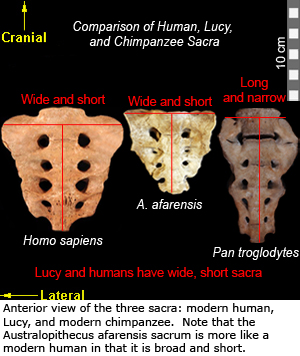 Additionally, Lucy’s sacrum is wide at the top (proximally) and short in length, although not to the extent observed in humans13. In contrast, the chimpanzee sacrum is long and narrow. You can see these differences in the picture to the right. A proximally wide sacrum positions the sacroiliac joint (where the sacrum articulates with the innominate) over the hip joints (where the femoral head articulates with the innominate). By aligning these joints, stress on the pelvis during bipedal walking is alleviated.
Additionally, Lucy’s sacrum is wide at the top (proximally) and short in length, although not to the extent observed in humans13. In contrast, the chimpanzee sacrum is long and narrow. You can see these differences in the picture to the right. A proximally wide sacrum positions the sacroiliac joint (where the sacrum articulates with the innominate) over the hip joints (where the femoral head articulates with the innominate). By aligning these joints, stress on the pelvis during bipedal walking is alleviated.
The size of the joint surfaces is related to the amount of weight transmitted through the pelvis during locomotion. A larger joint surface is better able to dissipate weight than a smaller joint surface. Lucy’s sacrum also has somewhat expanded joint surfaces compared to chimpanzee. However, again, they do not approximate the human condition completely. Humans have large sacral joint surfaces, even compared to gorillas! Human sacral joint surfaces are so large because their sacrum must withstand the entire weight of the upper body during bipedal posture and locomotion. In contrast, chimpanzees and gorillas have smaller joint surfaces because some of their body weight is transferred to the forelimbs during quadrupedal posture and locomotion. Overall, Lucy’s sacrum trends toward the human condition, indicating that she employed bipedal posture and locomotion.
eFossils is a collaborative website in which users can explore important fossil localities and browse the fossil digital library. If you have any problems using this site or have any other questions, please feel free to contact us.
Funding for eFossils was provided by the Longhorn Innovation Fund for Technology (LIFT) Award from the Research & Educational Technology Committee (R&E) of the IT governance structure at The University of Texas at Austin.
